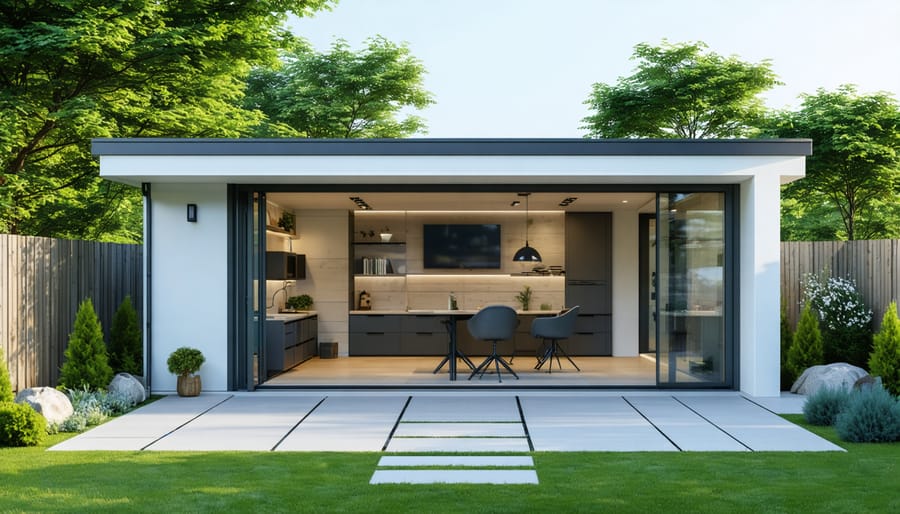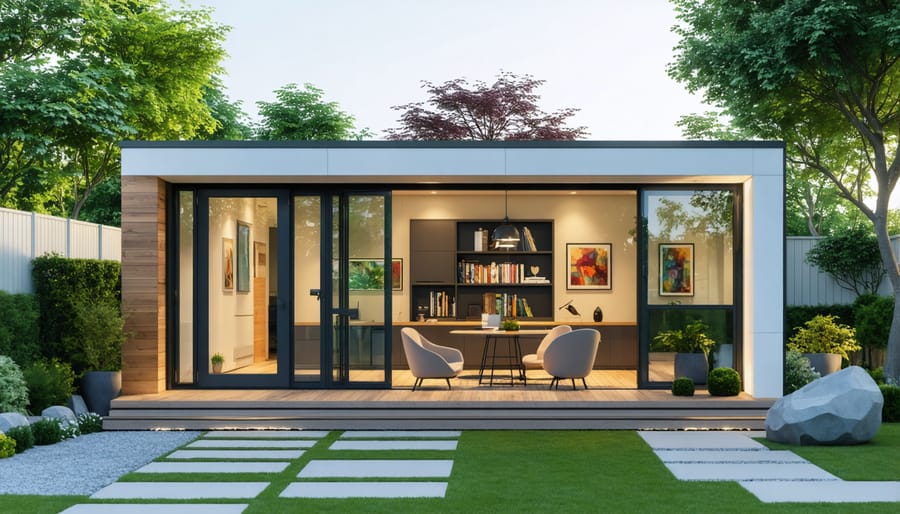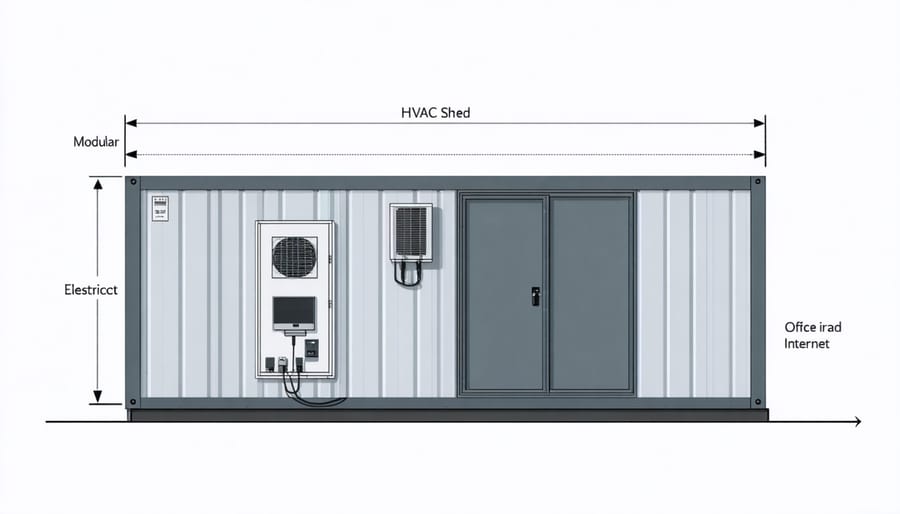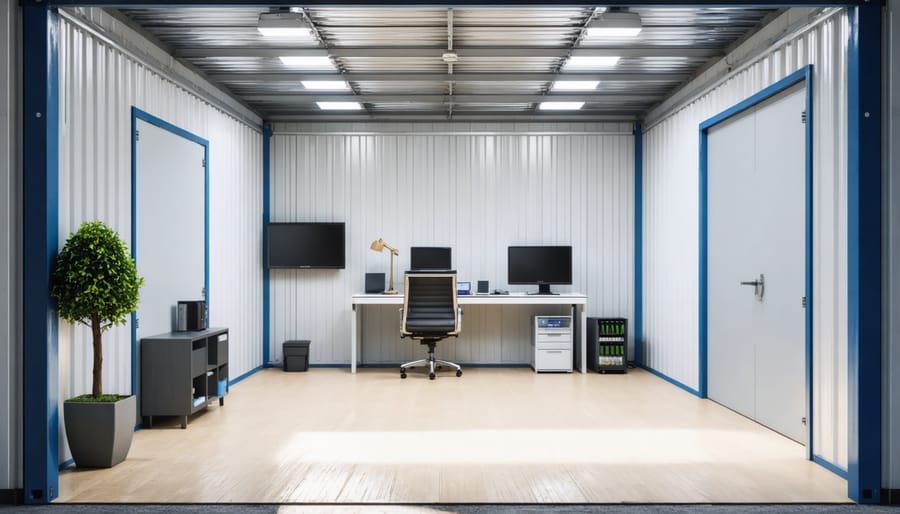Transform Your Backyard Into a Professional Home Office With a Modular Shed

Transform your home workspace with a modular shed office – the perfect solution for remote professionals seeking a dedicated, distraction-free environment without the complexity of traditional construction. These customizable structures combine the simplicity of shed design with modern office amenities, creating an ideal balance of functionality and comfort right in your backyard.
A modular shed office offers unparalleled flexibility, allowing you to choose from pre-designed layouts or customize every detail to match your specific work requirements. From compact 8×10 units perfect for solo entrepreneurs to spacious 12×16 configurations that accommodate small teams, these structures deliver professional-grade workspace solutions at a fraction of the cost of home additions or commercial rentals.
Beyond the practical benefits of separated work-life spaces, modular shed offices provide exceptional value through quick installation, minimal site preparation, and the ability to relocate if needed. With features like built-in electrical systems, climate control options, and natural lighting solutions, these innovative workspaces seamlessly blend the convenience of working from home with the productivity benefits of a professional office environment.
Whether you’re a full-time remote worker, creative professional, or small business owner, a modular shed office represents an investment in both your productivity and property value, offering a sophisticated solution to the modern challenge of creating dedicated workspace at home.

Why Choose a Modular Shed Office
Cost Comparison: Shed Office vs. Home Addition
When comparing costs, a modular shed office typically ranges from $5,000 to $15,000 fully equipped, while a traditional home addition can cost anywhere from $20,000 to $50,000 or more. This significant price difference makes shed offices an attractive option for budget-conscious homeowners.
Beyond the initial construction costs, shed offices offer additional financial benefits. They generally don’t require complex permits or extensive foundation work, saving both time and money. Installation usually takes just a few days, compared to weeks or months for a home addition, reducing labor costs substantially.
Property taxes are another consideration. While home additions typically increase your property tax assessment, shed offices often have minimal impact on your tax burden. Utility costs tend to be lower too, as these compact spaces are easier to heat and cool than larger home additions.
Maintenance costs also favor shed offices, with their simpler construction requiring less upkeep over time. Plus, if you eventually decide to move, a well-maintained shed office can be an attractive selling point without the major investment of a full addition.
Permits and Zoning Considerations
Before installing your modular shed office, it’s crucial to check local zoning laws and obtain necessary permits. Most municipalities require permits for structures over a certain size, typically 120-200 square feet. Contact your local building department to understand specific requirements for your area, including setback distances from property lines and height restrictions.
Many neighborhoods have homeowners’ associations (HOAs) with additional regulations about exterior structures. Review your HOA guidelines or get written approval before proceeding with installation. Common considerations include aesthetic requirements, maximum size limitations, and approved placement locations.
Your shed office may need to meet specific building codes, particularly if you’re planning to install electrical wiring or plumbing. These requirements often include proper foundation preparation, weather-resistant materials, and adequate ventilation. Some areas may require professional installation or inspection of utilities.
Remember to check if your home insurance policy covers the new structure, and consider updating your coverage accordingly. Taking care of permits and regulations early in the planning process helps avoid costly modifications or removal requirements later.
Essential Components of a Modular Shed Office
Foundation and Structural Requirements
A solid foundation is crucial for your modular shed office’s longevity and stability. Before installation, explore these best foundation options to ensure your workspace remains level and protected. Concrete slabs offer excellent durability and moisture resistance, while gravel foundations provide good drainage and cost-effectiveness. For temporary installations, concrete blocks with pressure-treated wood foundations work well.
Your shed’s structural integrity depends on proper weight distribution and support. Ensure the chosen foundation extends at least 12 inches beyond your shed’s dimensions on all sides. The ground should be carefully leveled, with a slight grade away from the structure to prevent water pooling.
Pay special attention to local building codes and permits, as requirements vary by location. Most areas require specific foundation depths and materials, especially for structures intended as workspaces. Consider hiring a professional for foundation installation to guarantee proper drainage, load-bearing capacity, and compliance with local regulations.
Remember to factor in utility connections when planning your foundation, as you’ll need appropriate channels for electrical wiring and possibly plumbing.
Insulation and Climate Control
Maintaining a comfortable working temperature in your outdoor office is crucial for year-round productivity. Insulating your shed office properly is the first step toward creating a climate-controlled workspace. Start with quality wall and ceiling insulation, using materials like fiberglass batts or spray foam to prevent heat loss in winter and keep cool air in during summer.
Consider installing double-pane windows to reduce thermal transfer and minimize outside noise. Weather stripping around doors and windows helps eliminate drafts and maintains indoor temperature consistency. For active climate control, a ductless mini-split system offers both heating and cooling capabilities without requiring extensive installation work.
Don’t overlook the importance of proper ventilation. Install at least one operable window and consider adding a small exhaust fan to prevent stuffiness and maintain good air quality. During moderate weather, natural ventilation can help reduce energy costs while keeping your workspace fresh.
For added comfort, consider installing reflective window film to reduce solar heat gain and use thermal curtains or blinds for additional temperature control. These simple additions can significantly impact your office’s comfort level throughout changing seasons.
Electrical and Internet Setup
A reliable electrical setup is crucial for a functional shed office. Start by consulting a licensed electrician to assess your needs and ensure compliance with local building codes. Most shed offices require a dedicated 20-amp circuit from your home’s main electrical panel, with proper underground conduit installation for safety and protection from the elements.
Plan your electrical layout carefully, including adequate power outlets for your office equipment, lighting, and climate control systems. Consider installing surge protectors to safeguard your electronics and LED lighting fixtures for energy efficiency. Remember to include exterior lighting for safety and convenience during darker hours.
For internet connectivity, you have several options. A hardwired ethernet connection through underground conduit provides the most reliable solution, though it requires careful installation. Alternatively, a mesh WiFi system or WiFi extender can create a strong wireless connection to your home network. Some homeowners opt for a dedicated internet line for their shed office, ensuring uninterrupted connectivity for video calls and online work.
Don’t forget to include USB charging ports and consider installing a backup power solution for critical equipment. Label all circuits clearly in your electrical panel for easy maintenance and troubleshooting.


Customization Options and Interior Design
Space-Saving Solutions
Making the most of your modular shed office space requires clever storage solutions and multi-functional furniture. Start with wall-mounted shelving units that keep your essentials organized while maximizing floor space. Consider installing floating desks that can be folded down when not in use, providing flexibility for different activities throughout the day.
Vertical storage is your best friend in a compact office environment. Install pegboards or slat walls to hang frequently used items like stationery, cables, and small equipment. Under-desk filing cabinets on wheels offer convenient storage that can be tucked away when needed, while corner shelving units utilize often-overlooked spaces.
Multi-purpose furniture plays a crucial role in space optimization. Choose a desk with built-in storage compartments, or opt for modular furniture pieces that can be reconfigured based on your needs. Storage ottomans serve as both seating and storage space for office supplies or reference materials.
Don’t forget about the ceiling space – overhead storage racks can hold seasonal items or rarely-used materials. Cable management solutions, such as under-desk trays and wall-mounted cable organizers, help maintain a clutter-free workspace while keeping everything accessible.
For a professional touch, incorporate drawer organizers and desktop sorting systems to keep small items tidy. Remember, the key to a productive shed office is having everything you need within reach while maintaining an open, uncluttered environment.
Lighting and Window Placement
Proper lighting is crucial for creating a productive workspace in your modular shed office. Start by strategically positioning your shed to maximize natural light exposure. South-facing windows typically provide the most consistent daylight throughout the day, while north-facing windows offer gentle, diffused light that’s perfect for computer work.
Consider installing at least two windows to create cross-ventilation and enhance natural lighting. Place them on opposite walls when possible, and opt for larger windows that take up 15-20% of your wall space. Double-pane windows not only provide better insulation but also reduce glare and heat gain during summer months.
For artificial lighting, implement a layered approach. Install overhead LED panels or track lighting for general illumination, complemented by task lighting at your desk area. Under-cabinet lights can add ambiance while maximizing workspace visibility. Smart lighting systems allow you to adjust brightness levels throughout the day, matching your natural circadian rhythm.
Don’t forget about window treatments. Installing adjustable blinds or shades helps control glare and heat while maintaining privacy. Light-colored window frames reflect more light into the space, making your office feel brighter and more spacious. For optimal comfort, position your desk perpendicular to windows rather than directly facing them to minimize screen glare and eye strain.
Maintenance and Long-Term Care
Seasonal Maintenance Checklist
To keep your modular shed office in prime condition, follow this quarterly maintenance routine. In spring, inspect the roof and seals for winter damage, clean gutters, and check for signs of pest intrusion. Apply weather stripping if needed and ensure proper drainage around the foundation to prevent water damage.
During summer, focus on ventilation maintenance by cleaning air vents and checking that windows operate smoothly. Inspect exterior walls for paint damage or wear, and touch up as necessary to maintain weather protection. Test your cooling system and clean or replace filters to ensure optimal performance during hot months.
Fall maintenance should include checking insulation integrity, sealing any gaps around windows and doors, and ensuring heaters are functioning properly. Clear fallen leaves from gutters and around the foundation to prevent moisture buildup. This is also an ideal time to trim any overhanging branches that could damage your shed office during winter storms.
Winter calls for regular snow removal from the roof (if applicable in your area) and monitoring for ice dam formation. Keep pathways to your shed office clear and safe, and check that heating systems maintain consistent temperatures to prevent pipe freezing.
Year-round, inspect electrical connections monthly, clean windows regularly, and maintain proper humidity levels to protect your equipment and furnishings. Address any issues promptly to prevent minor problems from becoming major repairs.
Weather Protection Strategies
Protecting your modular shed office from weather elements is crucial for maintaining a comfortable and durable workspace. Start by climate-proofing your office space through strategic measures that work year-round.
Install proper insulation in walls, floors, and ceiling to regulate temperature and prevent moisture buildup. Quality weatherstripping around doors and windows helps maintain climate control while keeping drafts at bay. Consider adding storm windows or double-pane options for enhanced protection and energy efficiency.
Apply weather-resistant sealant to all exterior joints and seams, paying special attention to areas around windows, doors, and utility entry points. Install gutters and downspouts to direct rainwater away from the foundation, preventing water damage and soil erosion.
For regions with heavy rainfall, consider adding a slight slope to the roof design and using water-resistant materials like metal or high-grade asphalt shingles. In snow-prone areas, ensure your roof can handle the extra weight and install snow guards to prevent dangerous snow slides.
Don’t forget about ground-level protection – create a slight grade around the shed to encourage water runoff, and consider installing a vapor barrier beneath the flooring. Regular maintenance checks, especially before seasonal changes, will help identify and address potential weather-related issues before they become serious problems.
A modular shed office represents more than just an additional workspace – it’s an investment in your productivity, work-life balance, and property value. By creating a dedicated home office space separate from your main living area, you gain the perfect blend of professional focus and comfortable working conditions, all while maintaining the flexibility to adapt the space to your evolving needs.
Throughout this guide, we’ve explored how modular shed offices offer numerous advantages over traditional home office solutions. From their cost-effectiveness and quick installation to their customizable nature and minimal permit requirements, these structures provide an ideal solution for remote workers, freelancers, and entrepreneurs alike.
The beauty of a modular shed office lies in its versatility. Whether you need a simple workspace or a fully-equipped professional environment, the modular design allows you to create exactly what you need. Plus, with proper planning and maintenance, your shed office can serve you well for many years to come.
As more people embrace remote work and flexible career options, having a dedicated workspace at home becomes increasingly valuable. A modular shed office offers the perfect balance of separation from home life and professional functionality, all while adding value to your property.
Consider taking the next step toward creating your ideal home office space. With careful planning, thoughtful design, and proper implementation, your modular shed office can become the productive sanctuary you’ve been dreaming of.

